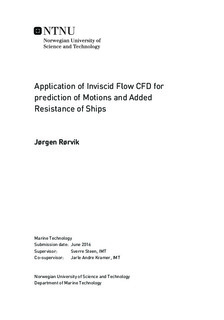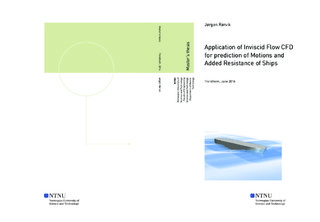| dc.description.abstract | Ships usually travels in waves, but their hull is normally optimized for calm water. One reason for this is that it is expensive to do accurate calculation of resistance in waves. Model test and URANS CFD is the most accurate methods. URANS is most suited for hull optimization and can give accurate results, but the computational cost is very high.
This thesis investigates if it is possible to calculate the added resistance on ships by applying an inviscid CFD code. It is a commonly accepted fact that viscosity have little effect on added resistance. It is believed that neglecting viscosity can significantly reduce the computational power required to do added resistance calculations, while retaining the good accuracy of CFD calculations.
The ship KVLCC2 was used for simulations. KVLCC2 is a 320m long VLCC which is used extensively in research. Both EFD and CFD data is available for calm water and regular head waves. The comparison data used in this thesis is mainly from the Gothenburg 2010 workshop on ship hydrodynamics (Larsson et al., 2014).
An inviscid numerical wave tank simulation was set up in STAR CCM+. The tank were built stepwise. A 2D tank was used to find a good mesh for the free surface such that the waves were correctly simulated. Similarly, a calm water simulation were used to set up the mesh around the ship hull to correctly capture the flow around the ship. For the calm water resistance study, both viscous and inviscid solvers where used. The calm water resistance from the viscous simulation were compared with model tests data and a good agreement was found.
The meshes from wave tank and clam water resistance were combined into a numerical wave tank. Regular and irregular JONSWAP wave conditions were tested. The result from the regular head wave conditions were compared with model test and viscous CFD results. The total resistance in head waves was found by adding the pressure resistance from the wave simulation with the friction and viscous pressure resistance from the viscous calm water simulations.
The inviscid wave tank gave results with equal order of accuracy as other viscous CFD computations when compared against model test data. A comparison was made between the viscous and inviscid simulation with same simulation setup in STAR CCM+. The difference between these simulations were much lower than the difference between viscous CFD and EFD results.
Saving potential by applying inviscid calculations instead of viscous with a two-equation turbulence model found to be between 30 and 50 %, depending on the mesh. The reduction is due to two effects. First, the turbulence is not modeled for inviscid flow, and that reduce the amount of equations being solved in each cell by two. Secondly, there is no boundary layer so the fine mesh applied to capture the boundary layer can be neglected.
The validity of the assumption that viscosity has little effect on added resistance was investigated. The friction resistance and viscous pressure resistance for a ship in head waves were compared against the same values for calm water. For both resistance components there was an increase in mean resistance, and both resistances oscillated with wave encounter frequency. This suggests that the added resistance due to waves is influenced by viscous effects.
This thesis only tested one hull geometry in head waves. More tests are necessary before a broader conclusion can be drawn. Oblique waves can give unseen challenges as additional degrees of freedom will be relevant. KVLCC2 is a large ship, and smaller ships will have larger relative motions. Large motions can cause stability problems in CFD, but might also cause phenomena not observed on the larger hull. | |

